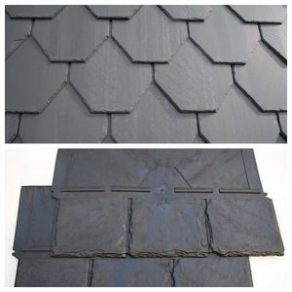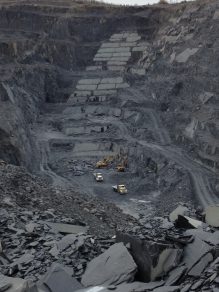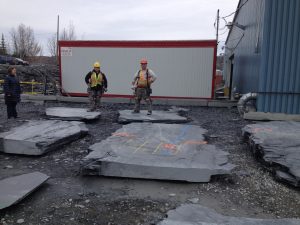

Natural roofing slate is quarried from the earth unlike fake, composite, faux, recycled rubber, synthetic slate products which are produced in a factory.
When it comes to selecting a roofing material most home and building owners want to know how much it costs and how long it will last. A good quality natural roofing slate will be the most expensive roofing product at $400-$600 per square but will last 100 years! When you understand the process involved in producing natural slate, you will understand the cost associated and the durability of the product.
North Country Unfading Black slate is produced by Glendyne in Saint-Marc-Du-Lac-Long, Quebec. Their opencut deposit is located along a dark grey slate bed. This deposit was discovered in the early 1900’s by Trans Canadian railroad workers. Between 1910 and 1915 slate was extracted but later abandoned during World War 1. In 1994, the quarry reopened and within a few years became one of the largest in North America.

Glendyne places a huge emphasis on mapping, test drilling and geological surveying to locate the best veins in the quarry. This reduces unnecessary extraction thus increasing the yield. Glendyne uses diamond wire sawing to minimalize fractures in the slate. Beads impregnated with industrial diamonds are threaded on to a continuous wire loop which is wrapped around the area of slate to be extracted. The diamonds gently cut through the slate. Once the block has been cut, it is extracted from the rockface with a hydraulic “pecker” to split it into more manageable sizes as some pieces can weigh over 5 tonnes. The blocks are then transported to the saw shop where they are marked for cutting dimensions by a skilled worker who carefully examines the slate for faults and inclusions.
The block passes through a Primary Saw which cuts along the grain of the slate for the length and the Secondary Saw which cuts the width. The sawn blocks are sent to the splitting department which can be done by hand with a chisel and hammer or by using a semi-automated pneumatic machine. These blocks are split into 8 and split until the desired thickness is reached (3/8”, ¼” and 3/16”). Once split, the chips are trimmed to produce the bevelled edge appearance and holes are punched creating a spalled countersink. Glendyne prides themselves on quality control and each piece of slate is graded before it is packed into pallets.
So after reading how a piece of roofing slate is produced the man-made synthetic products on the market shouldn’t be called “slate”. Let’s face it; they can’t compete with what Mother Nature created over 500 million years ago!

What % of slate extraction ends up as spoil?
Thanks
Mick